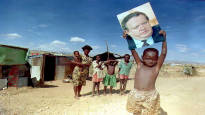In this story, we go through Ahtisaari’s methods as a peace broker in Namibia, Aceh, Kosovo and Northern Ireland. Test how you would do.
Saana Uosukainen
Sakari Nuuttila
Marja Väänänen
Ilkka Kemppinen
President Martti Ahtisaari did his life’s work as a peace mediator in Namibia, Aceh, Kosovo and Northern Ireland. He was awarded the Nobel Peace Prize for his work in 2008.
We present the most important insights of each project and Ahtisaari. You get to test your own abilities as a peace mediator.
Namibia, 1989–1990
Namibia’s independence process has lasted twenty years, and it has meant bloody battles between the independence-seeking Swapo and South African forces. South Africa finally gives up Namibia.
It is April 1989. The UN-supervised independence project has just begun, and you have arrived in Namibia as the UN Secretary General’s special representative. You hear that fighting has flared up again on the northern border. Hundreds had died.
This is how Namibia is doing now
Namibia is still an independent state and a multi-party democracy. The South West African People’s Organization (SWAPO) has ruled the country since independence. According to the 2023 report of the non-governmental organization Freedom House, there are only four countries in Africa that can be called free countries based on their governance. One of them is Namibia. The protection of civil liberties is solid in Namibia, but income differences are very large.
Aceh, Indonesia, 2005
The Aceh conflict on the northern tip of the island of Sumatra has lasted almost three decades. Opposite are the Indonesian troops and the soldiers of the Free Aceh movement. At least 12,000 people have been killed in the fighting. You are the chief negotiator, and the negotiations will move to Helsinki.
Aceh today
There is peace in Aceh, almost two decades after the peace agreement was signed. The peace process laid the foundation for the province’s stability. There are still financial challenges. The situation in Aceh also reminds us that building peace does not end with a peace agreement, but that the parties must work towards it every day, says CMI.
Kosovo, 1999
There has been a bloody war in the Balkans between the forces of Yugoslavia and Kosovo, which is seeking independence from it. President of Yugoslavia Slobodan Milošević refuses to sign a peace agreement that would guarantee Kosovo’s independence and enable NATO forces to operate in Kosovo. Because of this, NATO has decided to intervene in the conflict and started bombing Yugoslavia. You travel to Belgrade, the capital of Yugoslavia, to present the peace terms to President Milošević.
Kosovo today
Balkan expert Ker-Lindsay last summer described the current situation in Kosovo and Serbia as a stalemate. Only half of the world’s countries have recognized Kosovo’s independence, and unrest in the region continues.
Northern Ireland, 2000
A couple of years ago, the Belfast peace agreement was reached in Northern Ireland. Protestant monarchists and Catholic republicans have laid down their arms. You have been asked to ensure that the peace agreement is respected.
The current situation in Northern Ireland
Peace prevails in Northern Ireland, although the opponents of the peace agreement have resorted to acts of violence from time to time. The peace process is considered a historical example of how sustainable peace can be built. The inclusion of women and civil society played an important role.
Sources: CMI, Finnish Mission SocietyOver, Freedom House 2023 Report.
